INCENSE INGREDIENTS
The incense that matures
The artful blending of carefully selected natural ingredients makes Shoyeido’s incense unique and exclusive. The finest quality ingredients are procured by our master blenders and skillfully crafted to perfection.
The blending process requires an enormous amount of skill. When blending with natural ingredients, the quality, balance and ratio of each element is critical. The slightest variation in amount or quality of any component can dramatically influence the resulting fragrance. The amount of moisture, along with drying time and production methods, can also strongly affect the scent. Shoyeido has been refining these techniques for three hundred years ensuring that nothing goes to waste in this detailed production process.

The ingredients are finely ground and carefully mixed with a powdered, natural binding material, “Tabuko.” Up to fifty varieties of herbs and spices are precisely blended with pure water, quickly shaped, and dried very slowly.
As it is made with such care and contains the finest natural ingredients, Shoyeido incense matures and
improves with time. The scent becomes deeper and more mellow, reflecting the subtlety and refinement for which Shoyeido is known.
Traditional Japanese Incense from the Finest Ingredients A Gift of Nature
Many kinds of unusual roots and bark are used, such as magnolia, peony and cypress. Our master blenders also use plants and spices to create our products. These ingredients have been highly prized for centuries.
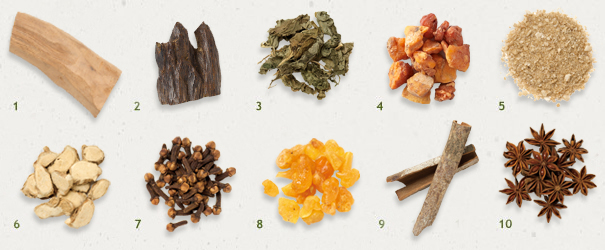
1.Sandalwood (Byaku-dan)

A tall evergreen tree cultivated in India, Indonesia and Malaysia, Sandalwood is also mentioned in old Sanskrit and Chinese books. Those from the Mysore region in southern India are called Rozan Byakudan in Japanese, and are known for their premium quality.
Sandalwood is often used for traditional Chinese medicine, incense or wooden sculptures.
2.Agarwood (Jin-koh)
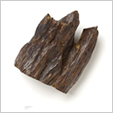
Agarwood is produced by a tree of the genus Aquilaria. These trees accumulate resin within their xylem, and when influenced by natural phenomena, the resin matures while the tree withers. It can be found in the Indochina peninsula, India, and the Hainan Island of China. In addition to incense, it is also use as sedative medicine and remedy for stomach aches. The highest grade of Agarwood is called Kyara, which means "precious" in ancient Japanese. The deeply resinous Kyara is much rarer than common types of agarwood, and has distinct and extraordinary aromatic characteristics.
3.Patchouli (kakkoh)
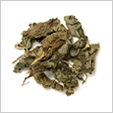
Patchouli is highly recognizable or its warm, woodsy scent. Derived from an Asiatic shrub tree which resembles a beefsteak plant, the leaves yield fragrant oil. Originated in the Philippine Islands.
4.Benzoin (Ansoku-koh)
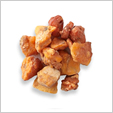
The sweet, balsamic resin from a tall deciduous tree of the family Styracaceae, Benzoin is found in tropical Sumatra. It yields a warm, mild scent.
5.Borneol (Ryu-no)
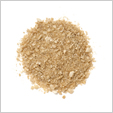
Derived from the camphor tree, the family Dipterocarpacae. Borneo Camphor is a crystalline substance, which accumulates in the gaps of the trunk. A natural insect and moth repellent.
6.Ginger Lily (San-na)
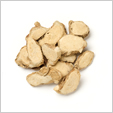
The dried root of a plant, native to Vietnam, and also grown in India and southern China, this plant bears delicate, fragrant, orchid-like flowers; and is highly prized for its warm, sweet and spicy fragrance.
7.Clove (Cho-ji)
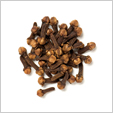
Clove is the dried flower buds from tall evergreen trees, the family Myrtaceae, and is native to the Molluques and Zanzibar Islands. Its hot, spicy scent has made it one of the most well-known spices in the world.
8.Frankincense (Nyu-koh)
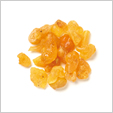
One of the most highly prized substances in the ancient world, Frankincense has been used in the ceremonies of many religions. It is found in the resin of trees, the family Burseraceae, grown in northeast Africa, the coasts of the Arabian Sea and Somalia. Known as a pain-relief agent in herbal remedies.
9.Cinnamon (Keihi)

The dried bark from a plant of the family Lauraceae, Cinnamon is produced in the southern provinces of China, Vietnam, Sri Lanka and Indonesia. One of the oldest spices known to man, it was traded between India, China and Egypt over 4,000 years ago. Cinnamon is mentioned in the Bible, as well as Greek and Roman pharmacopoeia.
10.Star Anise (Dai-uikyo)
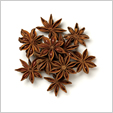
Considered one of the main medicinal and culinary plants, the dry fruit from the family Magnoliaceae has a lively, sweet and herbaceous scent and is mainly grown in the southern provinces of China. A popular ingredient for Chinese cuisine.
*Note on export Agarwood and Agarwood-related products
Agarwood is listed as an Appendix II item by CITES (the Convention of International Trade of Endangered Species). While Appendix II items are not immediate danger of extinction, they are being closely monitored and international trade is restricted. If you wish to import Agarwood or Agarwood-related products from Japan, you must allow for time to have an export permit secured and specific shipping procedures must be implemented to comply with CITES guidelines.
Please feel free to contact Shoyeido Incense Co. for more information:
Shoyeido Sales Department
Tel: +81 75 212 5590
Email: incense@shoyeido.co.jp

